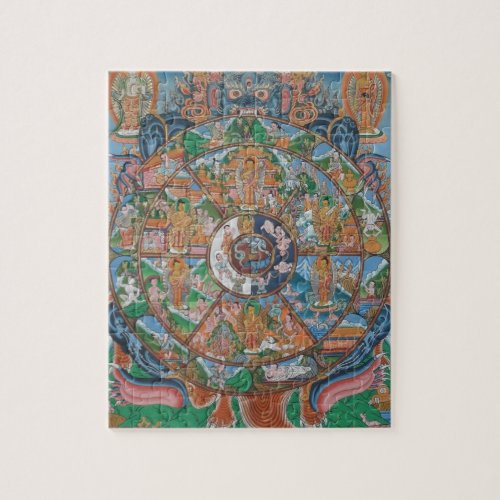Wheel of Life Mandala Puzzle



About Mandalas Mandala is a Sanskrit word that means "circle". In the Buddhist and Hindu religious traditions their sacred art often takes a mandala form. The basic form of most Hindu and Buddhist mandalas is a square with four gates containing a circle with a center point. Each gate is in the shape of a T. These mandalas, concentric diagrams, have spiritual and ritual significance in both Buddhism and Hinduism. The term is of Hindu origin, but is also used in Buddhism. In the Tibetan branch of Vajrayana Buddhism, mandalas have been developed into sandpainting. In various spiritual traditions, mandalas may be employed for focusing attention of aspirants and adepts, as a spiritual teaching tool, for establishing a sacred space, and as an aid to meditation and trance induction. Its symbolic nature can help one to access progressively deeper levels of the unconscious, ultimately assisting the meditator to experience a mystical sense of oneness with the ultimate unity from which the cosmos in all its manifold forms arises The psychoanalyst Carl-Gustav Jung saw the mandala as "a representation of the unconscious self" . In common use, mandala has become a generic term for any plan, chart or geometric pattern that represents the cosmos metaphysically or symbolically, a microcosm of the Universe from the human perspective. The Wheel of Life The bhavacakra is a symbolic representation of samsara (or cyclic existence) found on the outside walls of Tibetan Buddhist temples and monasteries in the Indo-Tibet region. In the Mahayana Buddhist tradition, it is believed that the drawing was designed by the Buddha himself in order to help ordinary people understand the Buddhist teachings. The bhavacakra is popularly referred to as the Wheel of Life. The meanings of the main parts of the diagram are: 1. The images in the hub of the wheel represents the three poisons of ignorance, attachment and aversion. 2. The second layer represents karma. 3. The third layer represents the six realms of samsara. 4. The fourth layer represents the twelve links of dependent origination. 5. The fierce figure holding the wheel represents impermanence. 6. The moon above the wheel (top left in the image at right) represents liberation from samsara or cyclic existence. 7. The Buddha pointing to the moon indicates that liberation is possible. Symbolically, the three inner circles, moving from the center outward, show that the three poisons of ignorance, attachment, and aversion give rise to positive and negative actions; these actions and their results are called karma. Karma in turn gives rise to the six realms, which represent the different types of suffering within samsara. The fourth and outer layer of the wheel symbolizes the twelve links of dependent origination; these links indicate how the sources of suffering—the three poisons and karma—produce lives within cyclic existence. The fierce being holding the wheel represents impermanence; this symbolizes that the entire process of samsara or cyclic existence is impermanent, transient, constantly changing. The moon above the wheel indicates liberation. The Buddha is pointing to the moon, indicating that liberation from samsara is possible.


